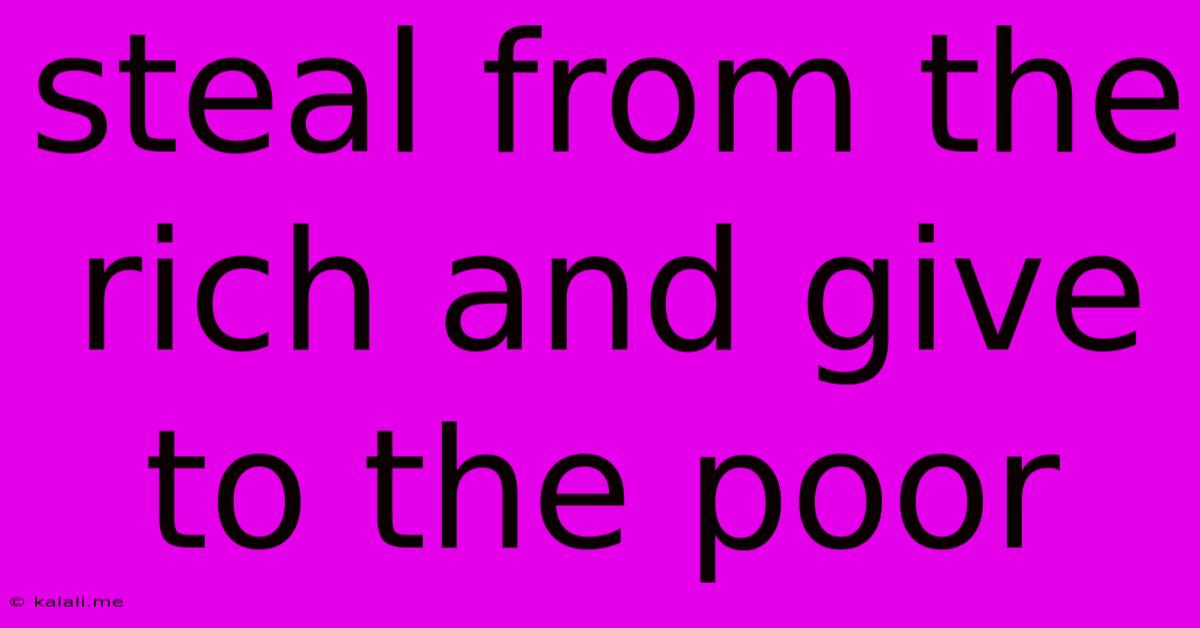Steal From The Rich And Give To The Poor
Kalali
Jun 04, 2025 · 3 min read

Table of Contents
Steal From the Rich and Give to the Poor: A Robin Hood Myth and Modern Realities
Meta Description: Exploring the timeless Robin Hood tale and its relevance today. We examine the ethical complexities of wealth redistribution, its historical context, and the modern movements inspired by this iconic figure.
The phrase "steal from the rich and give to the poor" evokes the legendary Robin Hood, a symbol of rebellion against injustice and inequality. While the romantic image of a heroic outlaw redistributing wealth resonates across centuries, the reality of such actions is far more complex and raises crucial ethical and economic questions. This article explores the historical context of this concept, examines its modern manifestations, and delves into the ongoing debate surrounding wealth redistribution.
The Robin Hood Legend and its Enduring Appeal
The Robin Hood legend, steeped in folklore and romanticized narratives, portrays a nobleman who robs the corrupt Sheriff of Nottingham and other wealthy oppressors to aid the impoverished people of Sherwood Forest. His actions, though illegal, are justified by the perceived injustice of the existing social order. This narrative taps into a deep-seated human desire for fairness and a rejection of unchecked power and extreme wealth disparity. The enduring appeal of Robin Hood lies in his symbolic representation of resistance against tyranny and the fight for social justice. He’s a hero for the marginalized, a champion of the common person against systemic oppression.
Historical Context: Taxation, Revolution, and Social Upheaval
Throughout history, the concept of seizing wealth from the affluent to alleviate poverty has manifested in various forms. From peasant revolts and tax rebellions to revolutionary movements, the redistribution of wealth has often been a central theme. The French Revolution, for instance, was fueled by resentment towards the aristocracy's lavish lifestyles and the stark contrast with the poverty experienced by the majority of the population. While the methods employed varied greatly, the underlying motivation – a desire for a more equitable society – remains consistent. Think of the historical significance of progressive taxation as a form of regulated wealth redistribution.
Modern Interpretations: Progressive Taxation and Charitable Giving
Today, the idea of “stealing from the rich” is generally understood not through illegal acts, but through progressive taxation and robust social welfare programs. Progressive taxation, where higher earners pay a larger percentage of their income in taxes, is a cornerstone of many modern economies. The revenue generated is then used to fund public services like healthcare, education, and social security, effectively redistributing wealth from the wealthy to those in need. This is a legalized and regulated form of wealth redistribution, aiming for a more equitable distribution of resources and opportunities.
Furthermore, charitable giving and philanthropic endeavors play a significant role in modern wealth redistribution. Individuals and foundations contribute billions of dollars annually to various causes, aiming to alleviate poverty, fund research, and support social programs. This demonstrates a voluntary approach to wealth redistribution, driven by individual compassion and a commitment to social responsibility.
Ethical Considerations and Economic Impacts
The debate surrounding wealth redistribution is complex and often highly politicized. Critics argue that excessive taxation stifles economic growth by discouraging investment and entrepreneurship. They also raise concerns about the efficiency and effectiveness of government programs aimed at alleviating poverty. Conversely, proponents of wealth redistribution highlight the moral imperative of addressing extreme inequality and the positive social and economic impacts of investing in human capital through education, healthcare, and social safety nets.
The discussion also brings up important ethical considerations around property rights, individual liberty, and the role of government in regulating economic activity. Finding a balance between individual rights and social responsibility remains a key challenge in this ongoing debate.
Conclusion: A Continuing Dialogue
The enduring appeal of the "steal from the rich and give to the poor" ethos reflects a persistent desire for social justice and economic equality. While the methods and mechanisms for achieving this goal remain a subject of ongoing debate, the underlying principle – the need for a fairer distribution of resources – continues to inspire movements and policies around the world. The conversation must continue to evolve, incorporating economic realities, ethical considerations, and a commitment to creating a more just and equitable society for all.
Latest Posts
Latest Posts
-
Dnd Bag Of Holding In A Bag Of Holding
Jun 06, 2025
-
Do All Colors Of Light Travel At The Same Speed
Jun 06, 2025
-
How To Fix Torn Leather Couch
Jun 06, 2025
-
How To Make Money Lifeinvader Gta V
Jun 06, 2025
-
How To Fix Scratches On Car Wheels
Jun 06, 2025
Related Post
Thank you for visiting our website which covers about Steal From The Rich And Give To The Poor . We hope the information provided has been useful to you. Feel free to contact us if you have any questions or need further assistance. See you next time and don't miss to bookmark.